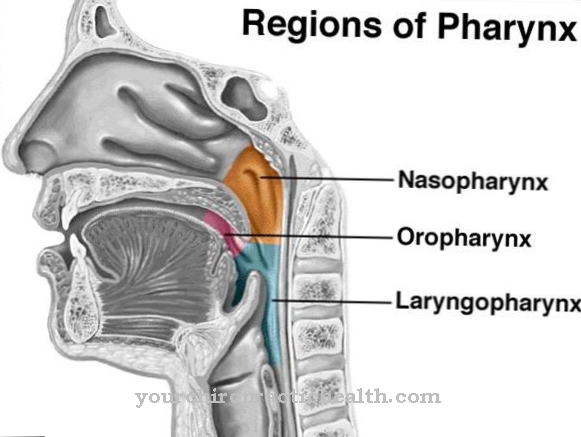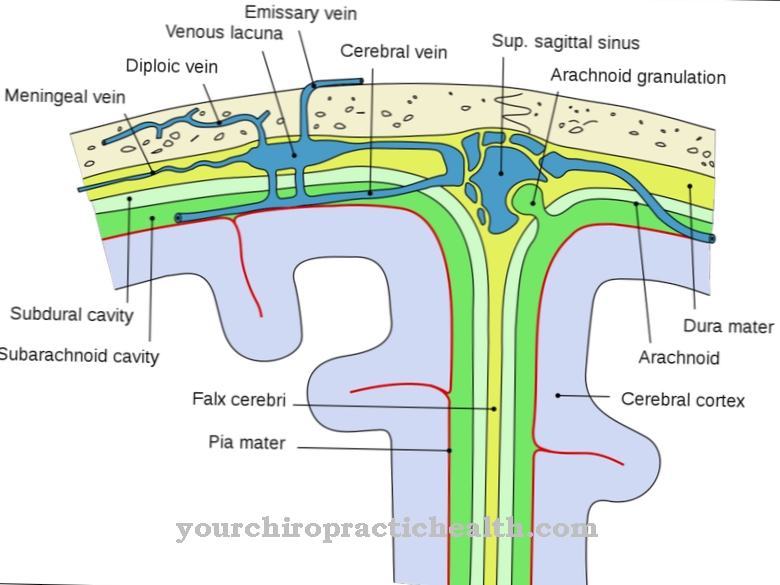Macrophages (Phagocytes) are white blood cells that belong to the evolutionarily oldest innate cellular immune system. Macrophages can escape from the bloodstream and survive in the body tissue as tissue macrophages for several months as a kind of police on guard.
One of their main tasks is to flow around infectious bacteria, degenerate endogenous cells or toxins like an amoeba and to phagocytize, ie to "eat" or otherwise render harmless and to transport them away.
What is the macrophage?
Macrophages, also called scavenger cells, belong to the phagocytes and thus to the innate cellular part of the immune response. If necessary, they develop from monocytes, which are formed from stem cells in the bone marrow and enter the bloodstream.
In the presence of a viral or bacterial infection that has been recognized by the immune system, the monocytes move close to the focus of the infection, leave the bloodstream and differentiate into fully functional macrophages. They can phagocytize the infectious germs at the source of the infection by completely enclosing the particles and breaking them down biochemically and catalytically using certain enzymes. The macrophages carry the corresponding enzymes with them in lysosomes, tiny cell organelles.
The macrophages are part of the innate, i.e. the genetically fixed immune system. There is a connection to the acquired immune system via the function of the antigen presentation of the macrophages, which is particularly triggered by viral infections. The presented antigens are recognized by the T-helper cells, which then stimulate the production of specific antibodies. Macrophages can significantly control inflammatory processes in tissue by secreting cytokines.
Anatomy & structure
Macrophage precursor cells are monocytes that are formed from stem cells in the bone marrow. Only under the influence of cytokines do monocytes differentiate into different types of macrophages. In the case of localized tissue macrophages that have migrated into the tissue, the morphology depends heavily on the surrounding tissue.
Anatomically, a macrophage corresponds practically to a single cell with a nucleus, cytoplasm, cytoskeleton and a multitude of organelles. A macrophage reaches a size of 25 to 50 µm. The size of the phagocytes is sufficient to capture a 5 µm long bacterium and lock it in one of its phagosomes. Lysosomes are available to macrophages for the perception of their main function, the phagocytosis of pathogens or the breakdown of a harmful substance.
These are small organelles that contain a number of degradation enzymes that are emptied into the phagosome after the pathogen has been captured in order to initiate and accomplish the actual phagocytosis. Macrophages also have the ability to synthesize lysozyme, which can break down glycosidic bonds. Direct contact with lysozyme causes bacteria to break down their cell walls.
Function & tasks
One of the main functions and tasks of macrophages is the phagocytosis of invading germs or other harmful substances. This also includes the body's own degenerate cells (cancer cells) that have been recognized as such by the immune system as well as cells that have already died. The macrophages are able to enclose the pathogens in one of their phagosomes and break them down into harmless individual components. Another main task is antigen presentation.
Most of them are peptide residues, i.e. components of certain proteins of phagocytosed germs, which the phagocyte "presents" to the outside via a complex mechanism. Certain T helper cells recognize the fragments presented and initiate the synthesis of specific antibodies. In interaction with other components of the immune system such as B and T lymphocytes as well as natural killer cells and fibroblasts, macrophages are able to produce a large number of cytokines. Cytokines are peptides and proteins with which the immune system controls the very complex immune response.
With interleukins, interferons, tumor necrosis factors and other substances that are assigned to the cytokines, the immune system controls the activation and deactivation of the immune components as well as the aggressiveness, the strength of the respective immune response, including possible attacks of fever. In the event of a virus infection, specialized CD-169-positive macrophages in the spleen take on the task of multiplying virus particles in order to accelerate a corresponding immune response.
In order to prevent viruses or virus parts that could escape from the macrophages from causing further infections, the CD-169-positive macrophages are tightly surrounded by other macrophages, which in such a case can immediately destroy the virus or virus parts that have escaped. The immune system also has non-phagocytic macrophages, which play an important role in the regeneration of muscle fibers. They produce control proteins that enable muscle cells to be transported and differentiated.
Diseases
Diseases and ailments that are directly related to malfunctioning macrophages are extremely rare. Diseases and symptoms that are based on overreactions of macrophages, but are triggered by another disease, are more common. This means that the symptoms can be traced back to a natural reaction of the phagocytes.
Hemophagocytosis Syndrome (HLH) is a rare disease that represents the causal relationship above. When this disease is present, the macrophages are so overactivated that they not only phagocytose old red blood cells that need to be disposed of, but also attack healthy cells in a kind of excessive immune response. The disease, which is often severe, can be inherited, i.e. based on certain genetic defects, but it can also be acquired. It can be triggered by drugs or infections.
A metabolic disease in which there is an incomplete breakdown of the intermediate product glucocerebroside, this substance accumulates in the lysosomes of the macrophages, which inflate as a result. Macrophages that have been modified in this way are called Gaucher cells, a term derived from the name of the disease, Gaucher syndrome. The accumulation of Gaucher cells in the liver, spleen and bone marrow as well as in the nervous system and other organs, if left untreated, leads to organ failure in the further course of the disease.
Typical & common diseases of the blood & erythrocytes
- Hemolysis
- Anemia (anemia), iron deficiency anemia
- Renal anemia
- Sickle cell anemia



.jpg)












.jpg)
.jpg)



.jpg)






